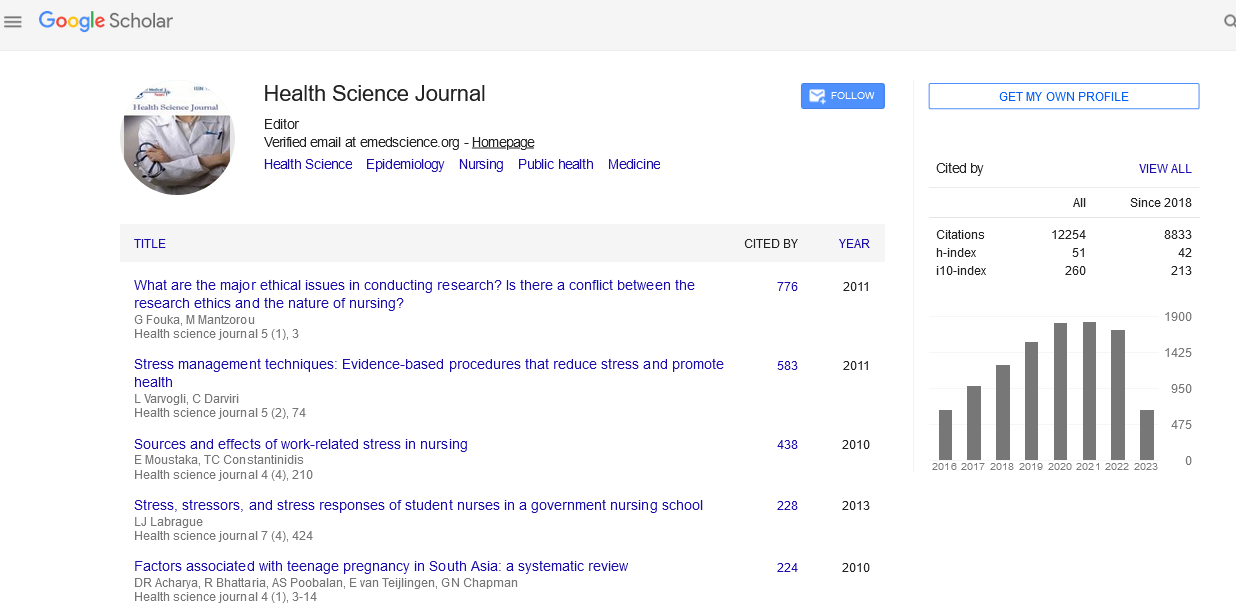Editorial - (2025) Volume 19, Issue 1
Investigating the Effects of Prenatal Exposure to Bisphenol A (BPA) on Neurological Development in Infants
John Michael Smith*
Department of Health Science, University of Bern, Switzerland
*Correspondence:
John Michael Smith, Department of Health Science, University of Bern,
Switzerland,
Email:
Received: 01-Jan-2025, Manuscript No. Iphsj-25-15518;
Editor assigned: 04-Jan-2025, Pre QC No. Iphsj-25-15518 (PQ);
Reviewed: 16-Jan-2025, QC No. Iphsj-25-15518;
Revised: 21-Jan-2025, Manuscript No. Iphsj-25-15518 (R);
Published:
30-Jan-2025, DOI: 10.36648/1791-809X.19.1.1219
Introduction
Bisphenol A (BPA) is a synthetic chemical compound commonly used in the production of plastics and resins. It is found in a variety of consumer products, including plastic bottles, food containers, and even medical devices. As an endocrine disruptor, BPA has been shown to interfere with the body’s hormone systems [1], leading to concerns about its potential effects on human health, particularly during critical developmental windows. One area of growing concern is the impact of prenatal exposure to BPA on the neurological development of infants. The fetus is particularly vulnerable to environmental toxins, and emerging evidence suggests that BPA may have detrimental effects on brain development, potentially contributing to neurodevelopmental disorders such as attention deficit hyperactivity disorder (ADHD), autism spectrum disorder (ASD) [2], and cognitive impairments. This article presents a study that investigates the effects of prenatal BPA exposure on the neurological development of infants, focusing on cognitive and behavioral outcomes in early childhood [3].
Background and Rationale
BPA has been a topic of concern for decades due to its widespread use and its ability to mimic estrogen, a key hormone involved in the regulation of numerous biological processes, including development, reproduction, and immune function. During pregnancy, the placenta provides a protective barrier, but it is not impervious to environmental toxins such as BPA [4]. Studies have shown that BPA can cross the placenta, exposing the developing fetus to potentially harmful levels of the chemical. The brain undergoes rapid development during pregnancy, with critical periods for neuronal proliferation, differentiation, migration, and synaptic formation. Any disruption during these processes can lead to long-lasting effects on neurological outcomes. BPA has been shown to affect neurodevelopment through several mechanisms, including the alteration of gene expression related to brain development, disruption of neurotransmitter systems, and changes in neurogenesis. Despite growing concerns, the specific effects of prenatal BPA exposure on infant neurological development remain an area of active research, with mixed findings regarding the extent and nature of the damage [5].
Study Design and Methodology
This study aimed to investigate the effects of prenatal exposure to BPA on neurological development in infants, with a focus on cognitive function, motor skills, and behavior. A cohort of pregnant women was recruited for the study, and their BPA exposure was assessed through the measurement of urinary BPA levels during the first, second, and third trimesters of pregnancy. These urine samples were analyzed to determine the concentration of BPA, which is considered a reliable biomarker of exposure. Infants born to these women were followed from birth through their early years of life [6], with regular assessments of neurological development at key milestones. Cognitive function was assessed using standardized developmental screening tools, such as the Bayley Scales of Infant Development (BSID) and the Mullen Scales of Early Learning (MSEL). These tools measure a range of developmental domains, including cognitive, motor, and language skills. In addition, behavioral assessments were conducted using parent-reported questionnaires, including the Child Behavior Checklist (CBCL), to identify any signs of developmental disorders, such as ADHD or autism-related behaviors. The study also examined the structural and functional aspects of brain development in a subset of infants using neuroimaging techniques. Magnetic resonance imaging (MRI) and functional MRI (fMRI) were used to assess brain volume, cortical thickness, and connectivity, which are all indicators of healthy brain development. This provided a more detailed understanding of how prenatal BPA exposure might affect the brain’s structure and function in early childhood.
Key Findings and Results
The results of the study demonstrated a clear association between prenatal BPA exposure and adverse neurological outcomes in infants. Higher levels of BPA exposure during pregnancy were linked to lower cognitive scores, particularly in domains related to executive function, memory, and problem-solving. These findings were consistent across different assessment tools, including the BSID and MSEL, which revealed that infants exposed to higher levels of BPA showed delays in motor development and language acquisition compared to those with lower exposure. In addition to cognitive delays, prenatal BPA exposure was associated with an increased risk of behavioral problems in early childhood. Parent-reported data from the CBCL indicated that children exposed to higher BPA levels during pregnancy exhibited more symptoms of hyperactivity, impulsivity, and inattention—hallmarks of ADHD. Furthermore, these children were more likely to display behaviors indicative of autism spectrum disorder, such as social communication difficulties and restricted, repetitive behaviors. Neuroimaging data provided additional insight into the underlying mechanisms of these developmental impairments. MRI scans revealed that infants with higher prenatal BPA exposure had reduced brain volume, particularly in regions associated with memory and executive function, such as the prefrontal cortex and hippocampus. fMRI results indicated altered functional connectivity in the brain, with reduced communication between key areas involved in attention and sensory processing. These structural and functional brain abnormalities were most pronounced in infants with the highest levels of BPA exposure. Importantly, the study also found that the timing of BPA exposure played a crucial role in determining the severity of the effects. Exposure during the first trimester, a critical period for brain development, was associated with the most significant cognitive and behavioral impairments. These findings suggest that early exposure to BPA may disrupt the brain’s development during a critical window, leading to long-lasting deficits.
Mechanisms of BPA-Induced Neurological Impairment
The study also sought to explore the potential mechanisms by which BPA affects neurological development. BPA’s ability to mimic estrogen and bind to estrogen receptors is thought to be one of the key pathways through which it disrupts brain development. Estrogen plays an essential role in neurogenesis, synaptogenesis, and the regulation of neurotransmitter systems during fetal brain development. By interfering with estrogen signaling, BPA may disrupt these processes, leading to abnormal brain structure and function. Furthermore, BPA has been shown to affect the expression of genes involved in neurodevelopment. For instance, BPA exposure has been linked to altered expression of genes that regulate synaptic plasticity and neuroinflammation, which are critical for normal brain function. Dysregulation of these pathways may contribute to the cognitive and behavioral deficits observed in the study. Another potential mechanism involves the disruption of the blood-brain barrier (BBB), a protective barrier that regulates the passage of substances between the bloodstream and the brain. BPA has been shown to increase the permeability of the BBB, potentially allowing toxins and inflammatory molecules to enter the brain and cause damage. This may contribute to the structural changes and impaired connectivity observed in the infants exposed to higher levels of BPA.
Implications for Public Health
The findings of this study underscore the importance of reducing prenatal exposure to BPA to protect fetal brain development. While BPA has been banned or restricted in many consumer products, particularly those designed for children, it remains prevalent in various environmental sources, including food packaging, water bottles, and household plastics. Pregnant women may unknowingly be exposed to BPA through their diet and everyday products, raising concerns about the continued public health impact of this chemical. The study’s results also highlight the need for further research into the long-term effects of prenatal BPA exposure. While this study focused on early childhood outcomes, it is possible that the neurological deficits observed in infancy could persist into later childhood and adulthood. Longitudinal studies are needed to track these children over time and assess whether the cognitive and behavioral impairments identified in the study worsen or improve with age.
Conclusion
This study provides compelling evidence that prenatal exposure to Bisphenol A (BPA) can have significant negative effects on the neurological development of infants. Higher levels of BPA exposure were associated with delays in cognitive and motor development, as well as an increased risk of behavioral disorders such as ADHD and autism. Neuroimaging data revealed structural and functional brain abnormalities in infants with high BPA exposure, suggesting that the chemical may disrupt brain development through multiple mechanisms, including hormonal interference and gene expression changes. These findings underscore the importance of reducing prenatal BPA exposure and highlight the need for further research into the long-term consequences of this ubiquitous chemical. Addressing the environmental sources of BPA exposure and promoting safer alternatives will be crucial in safeguarding the health of future generations.
References
- Abebe A (2012) Major challenges and gaps in rabies prevention and control. In Proceedings of the national workshop on rabies prevention and control in Ethiopia. 18-19.
Indexed at, Google Scholar
- Aga AM, Hurisa B, Urga K (2016) Current situation of rabies prevention and control in developing countries: Ethiopia perspective. Infectious Prev Med Infect Dis 4: 1-6.
Indexed at, Google Scholar, Crossref
- Ali A, Mengistu F, Hussen K, Getahun G, Deressa A (2010) Overview of rabies in and around Addis Ababa, in animals examined in EHNRI zoonoses laboratory between, 2003 and 2009. Ethiop Vet J 1491-1501.
Indexed at, Google Scholar, Crossref
- Cleveland S, Kaare M, Tiringa P, Mlengeya T, Barrat J (2003) A dog rabies vaccination campaign in rural Africa: impact on the incidence of dog rabies and human dog-bite injuries. Vaccine 21: 1965-1973.
Indexed at, Google Scholar, Crossref
- Collier L, Oxford J (2006) Human Virology. 3rd ed. Oxford University Press Inc New York, USA. 189-194.
Google Scholar
- Constable DP, Hinchcliff WK, Done SH, Grunberg W (2017) Veterinary Medicine A Textbook of the Diseases of Cattle, Horses, Sheep, Pigs, and Goats. 11th ed. Elsevier Missouri USA 1228-1238.
Google Scholar
Citation: Smith JM (2024) Investigating the Effects of Prenatal Exposure to Bisphenol A (BPA) on Neurological Development in Infants. Health Sci J. Vol. 19 No. 1: 1219.





